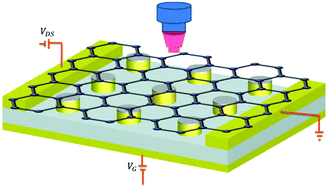Ultra-sensitive near-infrared graphene photodetectors with nanopillar antennas
Abstract
Graphene has been demonstrated as a candidate for optoelectronic devices due to its broad absorption spectrum and ultra-high carrier mobility. However, graphene is essentially transparent in visible and near-infrared regimes with an absorptivity of 2.3%, which largely limits its application in photodetection. Here, we show that metallic nanopillar antennas could improve light absorption in graphene detectors. The coupled antennas help to concentrate a free space electromagnetic wave around the nanopillars by localized surface plasmon resonance, strongly impacted by geometrical design. It is found that spectral selectivity can be realized by tuning key geometrical parameters such as period, radius, and height of the metallic nanopillar, leading to wavelength-tunable photodetectors within a broad range from 0.6 μm to 1.2 μm. With the optimized design, the detector exhibits an excellent photoresponsivity of 7 A W−1 at a wavelength of 0.82 μm.



 Please wait while we load your content...
Please wait while we load your content...